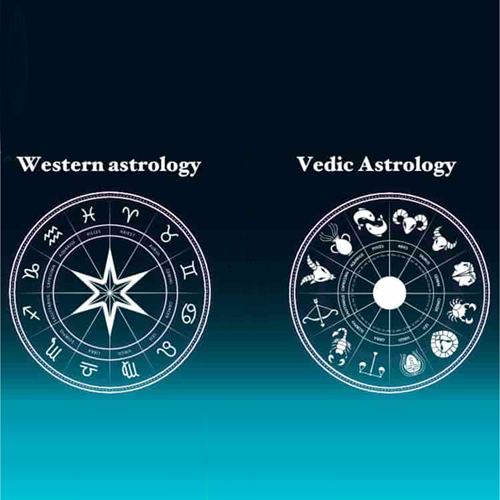1 of 1 parts
How Indian Astrology Differs From Western Ideas and Systems Of Astrology

Indian astrology has been practiced for thousands of years, and its influence has extended internationally to include individuals in many nations. Due to this, millions of Westerners have seen a significant change in their way of life. However, astrology has changed significantly since it migrated from Indian soil to western territories.
Even if modern astrology has its roots in Vedic knowledge, you may have experienced confusion on several occasions when presented with so many varying astrological remedies.
Though we can't say that the Western concept of astrology is entirely incorrect, it still has some fundamental flaws. In what precise way? Here is a brief overview of the ways that Indian and Western astrology are different.
How Is Indian Astrology Different From Western Astrology?
Signs and Constellations
Many of us have observed that while the beginning dates of the signs in traditional and Western astrology signs differ, there are a few comparable dates. Because of this overlap caused by the different locations, Vedic astrology is known as the zodiac of constellations, and Western astrology is frequently referred to as the zodiac of signs.
Connection with Philosophy
Vedic Astrology is derived from the ancient philosophy of the Vedas, which is why some of its fundamentals are standard with Ayurveda. Astrology and Vastu also share several fundamentals and work together to create harmony.
Planets
The Navgraha, or the nine planets, is the central figure in Vedic astrology. But these planets are not what we usually believe them to be. Vedic astrology has never included planets like Neptune, Uranus, and Pluto in its system of astrology because they are invisible to the unaided eye. As a result, the planets up to Saturn, the sun, the moon, and the moon's nodes, Rahu and Ketu, are given particular attention in Vedic astrology. In contrast, Western Astrology also emphasizes the outer planets.
Nakshatra
Vedic astrology employs a system of 27 moon signs known as Nakshatras in addition to the 12 zodiac signs that are well-known to us. After that, each moon sign is split into four subsections, or Padas, for 108 Nakshatra Padas. The philosophy underlying Western astrology is entirely devoid of this.
Remedial Measures
In Vedic astrology, the concept of the Karma cycle is highly valued. As such, it not only points out the past, present, and future consequences of Karma but also offers several remedial actions, or Upayas, to assist a person in overcoming the negative impacts of evil Karma. With the aid of Vedic astrology, a person's star energy can be balanced, and their entire quality of life can be enhanced. The idea of rebalancing Karma is not typically found in Western astrology.
As previously discussed, Western astrology is not entirely incorrect or misguided; instead, it deviates from the astrology our Vedas prescribed.
 Mental Abilities of Each Sign of the Zodiac
Mental Abilities of Each Sign of the Zodiac The Role of Venus in Love and Relationships: Understanding Its Influence
The Role of Venus in Love and Relationships: Understanding Its Influence Astrology and Health: How Your Zodiac Sign Can Affect Your Well-Being
Astrology and Health: How Your Zodiac Sign Can Affect Your Well-Being Astrology for Manifestation: How to Use Your Zodiac to Attract Abundance
Astrology for Manifestation: How to Use Your Zodiac to Attract Abundance Exploring the 12 Houses of the Zodiac: What Each One Represents
Exploring the 12 Houses of the Zodiac: What Each One Represents Astrology and the Law of Attraction: Aligning Your Zodiac with Your Desires
Astrology and the Law of Attraction: Aligning Your Zodiac with Your Desires
Latest Gossips
Mixed Bag
 How to Increase Blood Naturally: Simple Ways to Boost Hemoglobin Levels
How to Increase Blood Naturally: Simple Ways to Boost Hemoglobin Levels
Low hemoglobin levels or anemia can leave you feeling fatigued, weak, and drained. While it’s always...... Bag Collection One Should Have in Their Wardrobe
Bag Collection One Should Have in Their Wardrobe
A well-curated bag collection is an essential part of any wardrobe, combining functionality with fashion....... DIY Loaded Potato Skins with Unique Toppings
DIY Loaded Potato Skins with Unique Toppings
Crispy, golden potato skins loaded with delicious toppings are the perfect appetizer, snack, or party food...... The Incredible Benefits of Including Pomegranate in Your Diet
The Incredible Benefits of Including Pomegranate in Your Diet
The Incredible Benefits of Including Pomegranate in Your Diet...
Most Popular
Dare To Share
 Fear or Fight
Fear or Fight
My fiance does not know about my son and I am afraid that he will leave me once he finds out about this
Read More... Shameful Regret
Shameful Regret
He is planning to divorce his wife and probably marry me. However, he has transferred the three parcels of land and a car they have into my name...
Read More... Lover or Brother
Lover or Brother
I am 20 years old and in a relationship with a guy aged 24 years. My boyfriend is a brother to my cousin's.......
Read More...
check outclick money scam review. Recently, new review of click money is posted on clickmoneyscam.com

